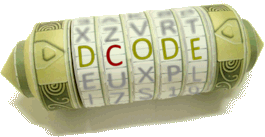Tool to convert frequency to visible color, understand the light spectrum, interpret light in terahertz and identify associated colors.
Color Wave Frequency - dCode
Tag(s) : Physics-Chemistry
dCode is free and its tools are a valuable help in games, maths, geocaching, puzzles and problems to solve every day!
A suggestion ? a feedback ? a bug ? an idea ? Write to dCode!
Color Wave Frequency
Frequency to Color Converter
Color to Frequency Converter
Answers to Questions (FAQ)
What is a color frequency? (Definition)
Frequency is a physical quantity measured in terahertz (THz), which indicates how many times an electromagnetic wave oscillates in one second.
In the case of visible light, this frequency determines the color perceived by the human eye.
The visible spectrum generally ranges from 384 THz, corresponding to red, to 789 THz, associated with violet.
How to convert a frequency to visible color?
Converting a frequency value in terahertz (THz) to a visible color on a screen, expressed as red, green, and blue (RGB), is not based on a universal formula.
Color perception varies slightly among individuals, making it difficult to establish an exact correspondence.
Nevertheless, there is a consensus on the approximate frequency ranges that make up the visible spectrum of light:
— 384–484 THz (Red)
— 484–508 THz (Orange)
— 508–526 THz (Yellow)
— 526–606 THz (Green)
— 606–668 THz (Blue/Cyan)
— 668–789 THz (Violet/Blue)
The cutoff values from one color to another are not perfectly defined.
Why do some colors not have a well-defined frequency?
Some colors do not have a specific frequency because they do not correspond to light composed of a single frequency (so-called monochromatic color).
Example: Pink and Magenta: result from a mixture of red and blue.
Example: Gray, white, black: depend on the perceived light level, ranging from total absence (black) to high luminance (white), including intermediate shades (gray).
Example: Brown/Tan: correspond to dark, undersaturated shades of orange or red.
Since these colors do not appear directly in the visible luminous spectrum, dCode seeks to approximate their representation based on a proximity measurement called Delta E distance.
What are non-visible frequencies like infrared or ultraviolet?
The electromagnetic spectrum includes many frequencies that are invisible to the human eye, categorized as follows:
— < 300 GHz: Radio waves and microwaves (used for communication, radio, Wi-Fi, radar).
— 300 GHz – 384 THz: Infrared (IR), perceived as heat, used in night vision and remote controls.
— 384 – 789 THz: Visible light.
— > 789 THz – 30 PHz: Ultraviolet (UV), can cause sunburns, used for sterilization.
— 30 PHz – 30 EHz: X-rays, can penetrate soft tissue, used in medical imaging.
— > 30 EHz: Gamma rays, very energetic, emitted by nuclear or astrophysical processes.
These radiations have various applications but do not produce direct visual perception.
Source code
dCode retains ownership of the "Color Wave Frequency" source code. Any algorithm for the "Color Wave Frequency" algorithm, applet or snippet or script (converter, solver, encryption / decryption, encoding / decoding, ciphering / deciphering, breaker, translator), or any "Color Wave Frequency" functions (calculate, convert, solve, decrypt / encrypt, decipher / cipher, decode / encode, translate) written in any informatic language (Python, Java, PHP, C#, Javascript, Matlab, etc.) or any database download or API access for "Color Wave Frequency" or any other element are not public (except explicit open source licence like Creative Commons). Same with the download for offline use on PC, mobile, tablet, iPhone or Android app.
Reminder: dCode is an educational and teaching resource, accessible online for free and for everyone.
Cite dCode
The content of the page "Color Wave Frequency" and its results may be freely copied and reused, including for commercial purposes, provided that dCode.fr is cited as the source.
Exporting the results is free and can be done simply by clicking on the export icons ⤓ (.csv or .txt format) or ⧉ (copy and paste).
To cite dCode.fr on another website, use the link:
In a scientific article or book, the recommended bibliographic citation is: Color Wave Frequency on dCode.fr [online website], retrieved on 2025-05-13,
